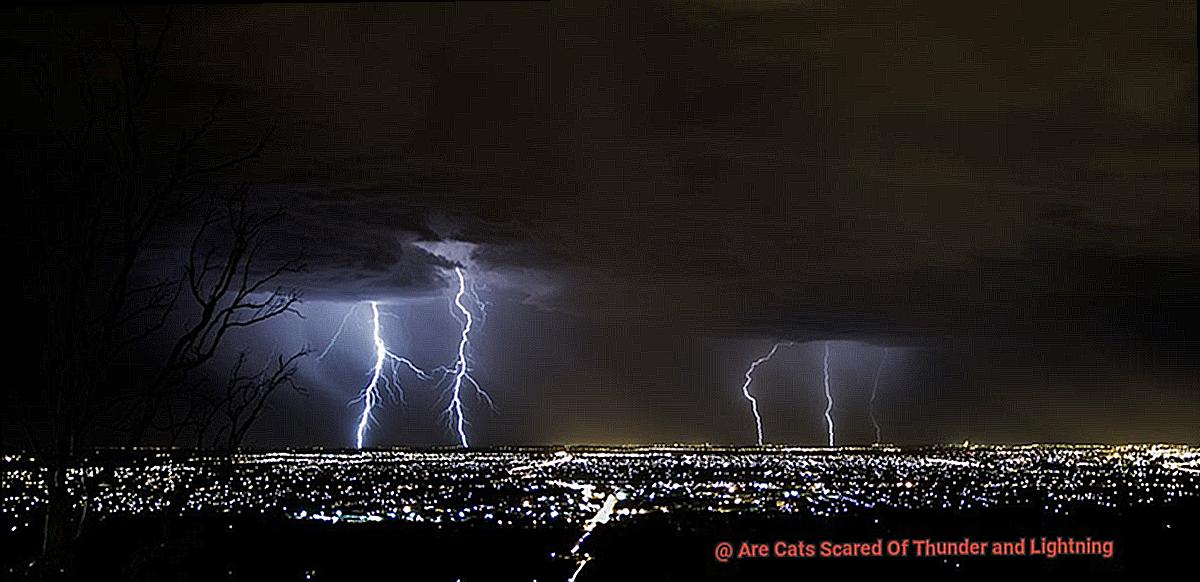Do cats get scared during a storm? Absolutely. Cats are afraid of thunder and lightning.
Their keen sense of hearing and smell make them extra sensitive to the loud boom of thunder and brilliant flash of lightning. When a storm approaches, cats may show signs of anxiety such as hiding, panting, trembling or vocalizing. Some cats may even try to run away from home.
As pet owners, it’s important to know how to help reduce your cat’s fear during storms. Provide them with a safe place like a dark closet or basement. Playing soothing music can also help drown out the sound of thunder and make your cat feel more relaxed. Offering extra attention can also help decrease their anxiety.
By understanding why cats are scared of thunder and lightning, you can ensure that your cat is safe in any weather condition. With patience and knowledge, you will be able to provide peace and reassurance for your beloved pet during storms.
How Cats React to Thunder and Lightning
Cats have a remarkable ability to detect changes in air pressure, which is why they can often predict approaching storms before humans. However, this same ability can make them particularly vulnerable to thunder and lightning. The loud noises, bright flashes of light, and gusts of wind can be terrifying for cats, leading to a range of behaviors that indicate their fear.
Your cat may hide under furniture or in other small enclosed spaces for safety, or they may become aggressive and protective by hissing and growling. Some cats may even become paralyzed with fear, refusing to move from their spot. Excessive meowing or panting can also be signs of distress and anxiety in cats during thunderstorms.
Fortunately, there are several ways you can help calm your cat during a thunderstorm. Providing them with a safe space away from windows and doors is important; choose an enclosed area such as a closet or bathroom and blanket it with soft bedding or blankets.
Pheromone sprays or diffusers also do a good job at imitating a cat’s natural pheromones and instilling a sense of security and stability. To drown out the sound of thunder and lightning, try relaxing music or white noise.
Understanding the Fear: Sensitivity to Pressure and Static Electricity

Cats are incredibly intelligent and sensitive creatures, particularly when it comes to loud noises. Thunder and lightning can be extremely frightening for cats, causing them to experience fear and even terror.
So why do cats become so afraid of thunderstorms? It turns out that cats’ fear of thunder and lightning is not only due to their loud sounds, but also their heightened sensitivity to pressure shifts and static electricity.
Cats have highly sensitive ears and can detect sounds at higher frequencies than humans. The sudden booming sound of thunder can be overwhelming for cats, leaving them feeling scared and anxious.
Additionally, the flashing lights of lightning can be disorienting for cats. Furthermore, strong winds and heavy rain can create pressure changes that cause discomfort in cats, leading to anxiety and fear.
Similarly, static electricity generated by thunderstorms can give cats an unpleasant sensation, making them cautious and fearful.
Kittens may be more susceptible to the fear of thunder and lightning than adult cats as their nervous systems are still developing and they may not understand the source or nature of the stimuli.
To help our cats feel more secure during thunderstorms, it’s important to recognize their sensitivity to pressure changes and static electricity. We can make a safe space for our cats by providing a quiet covered area away from windows or doors with soft bedding or blankets.
Creating a Safe Space for Your Cat

Creating a safe space for your beloved cat is essential to help them feel secure during thunderstorms and other stressful events. To start, find a quiet place in your home where your cat can feel comfortable and safe. This room should be away from windows and doors that may let in loud noises, light, or wind. Heavy curtains can also be hung on the windows to block out noise and light.
Familiarizing your cat with the safe room is key so they know this is a place they can go when they are feeling uneasy. Place their bed, toys, food, and water bowls in the room and encourage them to enter with treats or playtime. To help relax them further, add a pheromone diffuser to the room which releases calming scents.

During thunderstorms, turn on a white noise machine or play soothing music to drown out any loud sounds. You can also use a thundershirt—a tight-fitting shirt that provides pressure—to help calm your cat even more. Creating a safe space for your cat is not only important during thunderstorms but also during other stressful situations such as fireworks or when strangers visit your home.
Pheromone Sprays/Diffusers to Help Calm Your Cat
Cats can feel anxious and stressed during thunderstorms, fireworks, or visits to the vet. To help them stay calm and secure in these situations, pheromone sprays and diffusers are an effective alternative. Synthetic versions of natural feline pheromones are released into the air, giving cats a sense of familiarity and security.
The Feliway diffuser is one of the most popular products on the market today. It releases a synthetic version of the pheromone that cats produce when they rub their faces against objects, helping to reduce anxiety and stress in cats.
Studies have shown that Feliway diffusers can be especially helpful in reducing symptoms of feline anxiety-related disorders such as separation anxiety and scratching.
When using pheromone sprays or diffusers to soothe your cat, it’s important to choose a safe and effective product. Look for those that contain synthetic versions of natural feline pheromones, avoiding any with harmful chemicals or ingredients that could be detrimental to your cat’s health.
Additionally, make sure to follow the manufacturer’s instructions carefully when using these products for maximum effectiveness.
Creating a comforting environment with a pheromone diffuser can make all the difference for cats in stressful situations such as thunderstorms or fireworks displays. Not only will it help them feel more secure and safe, but it will also provide relief from other anxiety-inducing activities like new visitors or trips to the hospital.
The Benefits of Soothing Music or White Noise
When thunderstorms or other loud noises strike, cats can become overwhelmed with fear and anxiety. Fortunately, there is a simple and cost-effective way to help your feline friend find peace during these stressful times – playing soothing music or white noise.
Studies have shown that certain types of music, such as classical or soft rock, can have a calming effect on cats and reduce their anxiety levels. This type of auditory stimulation can also mask the sound of thunder, making the experience less overwhelming for cats. Additionally, it can distract them from their fear and redirect their attention to something more peaceful.
When choosing music or white noise for your cat, it is important to take their individual preferences into account. Some cats may prefer soft, slow music while others may respond better to faster, more upbeat tunes. Experiment with different types of music and sounds to see what works best for your cat.
It is also recommended to gradually introduce your cat to soothing music or white noise before a thunderstorm or other stressful event occurs. This can help them associate the sounds with a sense of calm and relaxation, rather than fear and anxiety.
Overall, playing soothing music or white noise can be an invaluable tool in helping cats stay relaxed during times of stress and reducing their fear of thunder and lightning.
Keeping Windows and Doors Closed During Storms
Thunderstorms can be a frightening experience for cats, but there are several ways you can help them feel safe. Keeping windows and doors closed is essential during storms as it reduces the noise and intensity of the lightning and thunder.
If you have a screen door, make sure to close it tightly as a gust of wind could fling it open and cause panic. Curtains or shades should also be closed to block out the flashes of lightning.
It’s important to keep your cat indoors during storms and ensure their collar has an ID tag in case they slip out. To create a secure place for them to hide away from windows and doors, put them under a bed or inside a closet.

You can also play calming music or turn on the TV to muffle the sound of thunder and lightning, providing them with a distraction from their anxiety.

Keeping Your Cat Indoors During Storms
A storm can be a frightening experience for cats and their owners alike. Not only are cats terrified by the sound of thunder and lightning, but they can also become disoriented and run away during a storm. Fortunately, there are several steps you can take to ensure your cat remains safe and calm during a storm.
First, create a secure environment for your cat. Provide them with a cozy hiding spot in your home, such as a cat bed or cardboard box filled with a soft blanket. Place this area in an isolated room where your cat can feel sheltered from the noise of the storm.
You can also play calming music or white noise to distract your cat from the chaos of the storm and promote relaxation. Pheromone sprays or diffusers, such as Feliway, can produce a comforting scent that helps your cat feel more at ease.
During storms, it’s important to keep your cat indoors and doors closed, as loud noises and flashes of lightning can startle them.
To reduce the amount of lightning visible outside, consider closing curtains or blinds. If you live in an area prone to severe weather such as tornadoes, make sure you have an evacuation plan in place; keep your cat’s leash, carrier and key documents (such as vaccination records) readily available in case you need to evacuate quickly.
Additional Tips for Calming Your Cat During Thunderstorms
Thunderstorms can be a terrifying experience for cats, as they are sensitive to loud noises and static electricity. As a pet parent, it is essential to keep your cat calm during a storm. Here are some tips to help you do just that:
Create a Safe Haven

Provide your cat with a safe and secure space away from windows and doors. This could be in the form of a comfortable bed, cozy crate, or even a cardboard box with a soft blanket. You could also add items with natural pheromones like Feliway to the area to help your cat relax.

Utilize White Noise
Playing white noise, classical music, or soothing sounds can help distract your cat from the thunder and lightning outside. This can help them relax and feel like they are not alone.
Playtime/Exercise
Keeping your cat occupied with playtime and exercise before the storm can help reduce anxiety levels. This can also help them become tired and more likely to rest during the storm.
Keep Calm
Your cat will sense your mood and emotions. Remaining calm and collected during the storm can help your cat feel at ease. Avoid getting agitated, as this can only escalate your cat’s anxiety levels.
Medication
If your cat has a severe anxiety disorder, you could discuss medication options with your vet. They may prescribe anti-anxiety medication to help calm your cat during a thunderstorm. However, this should only be considered as a last resort.
Conclusion
Thunder and lightning can be a terrifying experience for cats. But, with the right knowledge and preparation, you can provide your feline friend with a secure environment during storms.
It’s important to understand why cats are scared of thunder and lightning in order to help them feel more relaxed in any weather condition.
Playing soothing music or white noise can drown out the blazing sounds, while providing a safe space away from windows and doors is also essential. Pheromone sprays or diffusers that imitate natural feline pheromones can reduce anxiety in cats too.
Additionally, minimize the amount of thunder and lightning by closing windows and doors during storms. Finally, remaining calm yourself will help your cat stay more relaxed during difficult times.







